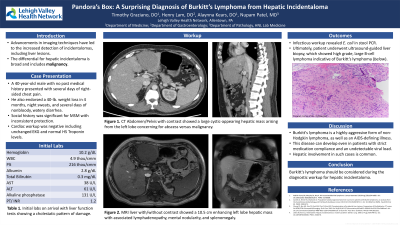Monday Poster Session
Category: Liver
P2601 - Pandora’s Box: A Surprising Diagnosis of Burkitt’s Lymphoma from a Hepatic Incidentaloma
Monday, October 23, 2023
10:30 AM - 4:15 PM PT
Location: Exhibit Hall

Has Audio

Timothy Graziano, DO
Lehigh Valley Health Network
Allentown, PA
Presenting Author(s)
Timothy Graziano, DO, Henry Lam, DO, Alaynna Kears, DO
Lehigh Valley Health Network, Allentown, PA
Introduction: Advancements in imaging techniques have resulted in the increased detection of incidentalomas, including incidental hepatic lesions. The differential for hepatic incidentaloma is broad, but importantly includes malignancy. Here, we present a unique case of hepatic incidentaloma that was ultimately found to be Burkitt lymphoma in the setting of newly diagnosed HIV.
Case Description/Methods: A 40-year-old male with no past medical history presented with several days of right-sided chest pain. On exam the chest pain was reproducible on palpation suggesting a musculoskeletal origin. Ischemic work-up was unrevealing with a benign EKG and normal troponins. CT chest was negative for thoracic pathology, but incidentally noted a large mass in the left liver lobe concerning for abscess versus malignancy. Lab work was significant for bandemia of 10% as well as abnormal liver function tests (total bilirubin 0.3 mg/dL, AST 38 U/L, ALT 61 U/L, alkaline phosphatase 131 U/L). Vitals revealed a low-grade fever of 100.8°F. Upon further questioning the patient reported unintentional weight loss of 40 pounds in 4 months, night sweats, and several days of non-bloody, watery diarrhea. He denied any sick contacts or travel history. Social history was significant for MSM. Given this constellation of findings, the patient was started on antibiotics for sepsis in the setting of diarrhea and possible liver abscess. Extensive infectious workup was positive for E coli in the stool as well as HIV. Follow-up imaging with MRI revealed a 10.5 cm contrast-enhancing left liver lobe mass with adjacent satellite lesions and lymphadenopathy most concerning for malignancy. Subsequent ultrasound-guided liver biopsy revealed high-grade lymphoma consistent with Burkitt’s lymphoma. The patient was discharged on antiretroviral therapy and referred to oncology where he was ultimately started on chemotherapy.
Discussion: Burkitt’s lymphoma is a highly aggressive form of non-Hodgkin lymphoma. It is a well-known complication and AIDS-defining illness in those with HIV. In fact, Burkitt’s lymphoma can develop even in patients who are compliant with antiretroviral therapy with undetectable viral load and robust CD4 counts. Hepatic involvement is common given its role as a major reticuloendothelial organ and is seen in up to 40% of cases of non-Hodgkin lymphoma. As such, it is crucial to consider Burkitt's lymphoma in the differential for hepatic incidentaloma given the aggressive nature of this malignancy.
Disclosures:
Timothy Graziano, DO, Henry Lam, DO, Alaynna Kears, DO. P2601 - Pandora’s Box: A Surprising Diagnosis of Burkitt’s Lymphoma from a Hepatic Incidentaloma, ACG 2023 Annual Scientific Meeting Abstracts. Vancouver, BC, Canada: American College of Gastroenterology.
Lehigh Valley Health Network, Allentown, PA
Introduction: Advancements in imaging techniques have resulted in the increased detection of incidentalomas, including incidental hepatic lesions. The differential for hepatic incidentaloma is broad, but importantly includes malignancy. Here, we present a unique case of hepatic incidentaloma that was ultimately found to be Burkitt lymphoma in the setting of newly diagnosed HIV.
Case Description/Methods: A 40-year-old male with no past medical history presented with several days of right-sided chest pain. On exam the chest pain was reproducible on palpation suggesting a musculoskeletal origin. Ischemic work-up was unrevealing with a benign EKG and normal troponins. CT chest was negative for thoracic pathology, but incidentally noted a large mass in the left liver lobe concerning for abscess versus malignancy. Lab work was significant for bandemia of 10% as well as abnormal liver function tests (total bilirubin 0.3 mg/dL, AST 38 U/L, ALT 61 U/L, alkaline phosphatase 131 U/L). Vitals revealed a low-grade fever of 100.8°F. Upon further questioning the patient reported unintentional weight loss of 40 pounds in 4 months, night sweats, and several days of non-bloody, watery diarrhea. He denied any sick contacts or travel history. Social history was significant for MSM. Given this constellation of findings, the patient was started on antibiotics for sepsis in the setting of diarrhea and possible liver abscess. Extensive infectious workup was positive for E coli in the stool as well as HIV. Follow-up imaging with MRI revealed a 10.5 cm contrast-enhancing left liver lobe mass with adjacent satellite lesions and lymphadenopathy most concerning for malignancy. Subsequent ultrasound-guided liver biopsy revealed high-grade lymphoma consistent with Burkitt’s lymphoma. The patient was discharged on antiretroviral therapy and referred to oncology where he was ultimately started on chemotherapy.
Discussion: Burkitt’s lymphoma is a highly aggressive form of non-Hodgkin lymphoma. It is a well-known complication and AIDS-defining illness in those with HIV. In fact, Burkitt’s lymphoma can develop even in patients who are compliant with antiretroviral therapy with undetectable viral load and robust CD4 counts. Hepatic involvement is common given its role as a major reticuloendothelial organ and is seen in up to 40% of cases of non-Hodgkin lymphoma. As such, it is crucial to consider Burkitt's lymphoma in the differential for hepatic incidentaloma given the aggressive nature of this malignancy.
Disclosures:
Timothy Graziano indicated no relevant financial relationships.
Henry Lam indicated no relevant financial relationships.
Alaynna Kears indicated no relevant financial relationships.
Timothy Graziano, DO, Henry Lam, DO, Alaynna Kears, DO. P2601 - Pandora’s Box: A Surprising Diagnosis of Burkitt’s Lymphoma from a Hepatic Incidentaloma, ACG 2023 Annual Scientific Meeting Abstracts. Vancouver, BC, Canada: American College of Gastroenterology.
